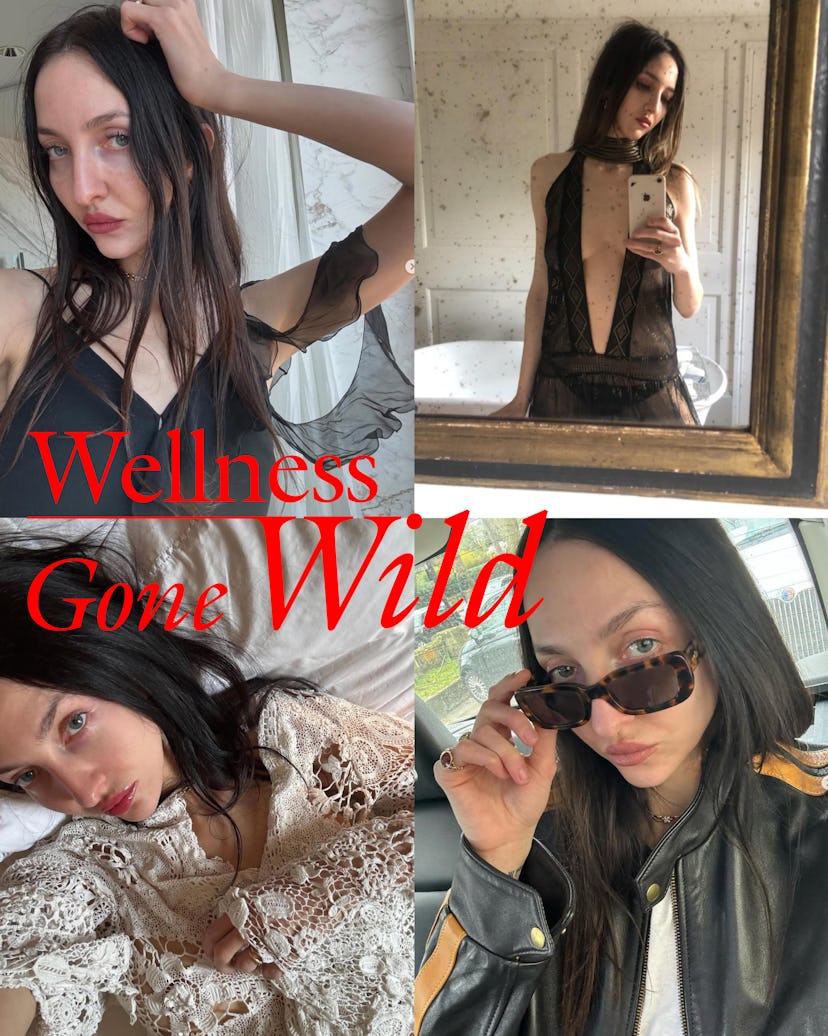Last December, during the aftermath of a particularly heady week, I finally decided to start living well.
Well, at least, marginally better than I had been. Between my steady diet of Babybel cheese, cigarettes, and lady petrol (you might know it as white wine), coupled with my chronic lack of sleep, general state of high anxiety, and violent aversion to physical activity—i.e. anything that made me feel tired or induced sweat, including walking to a taxi and climbing up stairs—things were not looking good. I was stressed, bloated, constipated, brain-foggy, exhausted, and depressed.
I could have just given up all my bad habits then and there, but that seemed impossible and kind of boring. Instead, I realized that if I wanted to continue living like a teenager, I would need some sort of wellness routine to balance out my unhealthy habits. But where to start? There was no way I was going to come up with a plan on my own. As with everything else in my life, I needed someone to do it for me—someone I both feared and revered in equal parts. And it had to be the kind of wellness practice I could relate to. Something a little weird and a bit nasty, none of that Lululemon yoga mat-wielding wellness Barbie malarkey.
I spent a few weeks researching various doctors, treatments, protocols and wellness centers near my home in London, until, finally, I came across a woman I’ll call Dr. A, a no-nonsense biomedical scientist and naturopathic doctor who specializes in biohacking and anti-aging. Her “natural” medicine practice offers an array of holistic treatments including ozone therapy, IV therapy, stem cell therapy, and EBO2 (a.k.a Extracorporeal Blood Oxygenation and Ozonation). She also specializes in bioresonance, which piqued my interest.
Employed in both holistic and intuitive medicine (i.e. medicine that is backed by absolutely zero sound scientific evidence), bioresonance is rooted in ideas of quantum physics, which says that all matter emits electromagnetic frequencies. Using a special machine, bioresonance measures the frequency of energy wavelengths coming from the body.
A beeping bioresonance machine.
Allegedly, cells and organs that are unhealthy will emit altered electromagnetic waves because of DNA damage. By comparing these abnormal frequencies to those of healthy cells, practitioners are supposedly able to ascertain various issues, sensitivities, and imbalances within the body.
It sounded a bit like voodoo nonsense, but it also sounded fun. Against better medical judgement, I booked an appointment.
Located in West London in a large office building, the practice is spread across two clinical-looking treatment rooms. Smallish in size, each one is dominated by a large treatment bed and has futuristic machines lined up against the walls. For my initial session, I sat in Dr. A’s office and revealed my life story—apparently, this is part of the diagnostic process. Next, Dr. A handed me a pair of electrodes, which were hooked up to the bioresonance machine and looked (as well as sounded) like the first machine man ever made—a cross between a wartime telegraph and the L. Ron Hubbard E-Meter, the Scientology device used to measure a person’s emotions. It was all very freaky, very sci-fi.
I sat there holding the electrodes for around 10 minutes, while the machine made a series of beeping noises. Just as I was about to write off the whole experience as nothing but witchy woo woo garbage, the machine began to spit out my results on Dr. A’s computer: overgrowth of harmful microflora in the digestive tract (which is probably why I couldn’t poop); systemic toxin in the liver (all that wine): nervous system showing signs of chronic exhaustion; patient in fight or flight mode. Then, it proceeded to list a bunch of things I was sensitive to and needed to unequivocally avoid if I wanted to start feeling well. Number one on the list: white wine.
I felt seen. No, I felt persecuted.
I’ve always known my lifestyle wasn’t the healthiest, but I guess I had been in denial. There was something about having my results laid out so clearly that made me want to take it seriously. Touching cloth with my mid-30s, and the mother of two small children with a hectic work schedule, I realized it was time to get my arse in gear if I wanted to live forever. So, I followed Dr. A’s protocol of supplements geared towards detoxing, as well as a diet of no dairy, gluten, or processed foods, and got a bunch of different IV treatments. Although it was likely a placebo, I did start to feel a tiny bit more full of life. I did this for about a month before eventually gaining the confidence to totally forget the routine and go rogue with my wellness, which I’ll be documenting henceforth in this column.
Welcome to my unhinged wellness journey.
P.S.: I’m not recommending electrodes, or futuristic boxes that beep like a submarine in lieu of medical advice; I’m just telling you what happened when I let one near me. If you actually care about your health, go see a proper doctor—the kind with a stethoscope.
